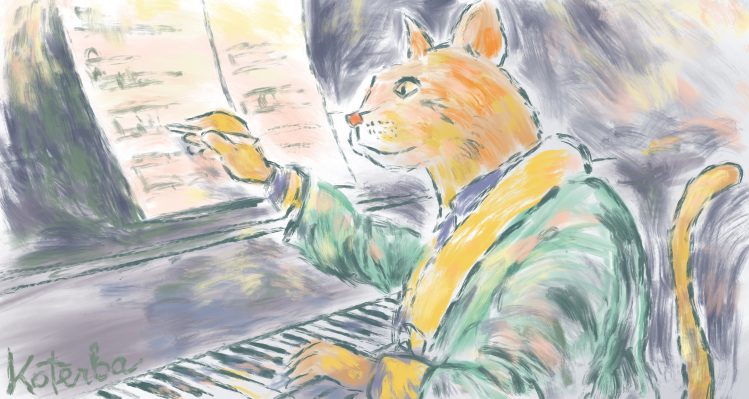
"An Impressionistic Cat" by Jeff Koterba
Cat Got Your Tune?
May 26th, 2024
For more than a century musicologists have compared the two French composers, Maurice Ravel and Claude Debussy. Although both shared the description of Impressionist, their musical, styles and techniques were quite different in many ways. However, both Ravel and Debussy had similar training, came under the same influences, were nonconformists, and both took classical music in a unique direction.
However, some distinguished music scholars have, for a century, overlooked perhaps the most important similarity that these two great composers shared. Ravel and Debussy were both renowned cat lovers! There is every indication that both suffered from co-dependent relationships with their felines. (I can speak with expertise about this complex issue because I’m in a co-dependent relationship with my dog). No serious musicologist should overlook such an important distinction in this day and age of pet indulgence!
It’s come to light that both Ravel and Debussy allowed their feline muses to prowl at liberty throughout their homes, unrestrained, trouncing among their music scores, and walking across masterpieces like Clair de Lune and Boléro with dirty paws.
Maurice Ravel spent much of his life in Paris, living in a villa called Belvedere, with his mother and his seven cats. Ravel was particularly fond of Siamese cats. All seven of his cats came from the same Siamese cat family. Author Jane Smith, in her 1995 book The Gift of Music, observes that “Ravel not only understood cats—he could actually speak their language.” A great example of this is Ravel’s opera about them. L’Enfant et les Sortilèges https://youtu.be/mcJGxzNJ8eo.
In her article “Classical Cats: The Feline Muses of Claude Debussy and Maurice Ravel,” writer Mimi Matthews notes that, like Ravel, Claude Debussy shamelessly indulged his felines. Matthews notes that Debussy preferred Angora cats and named each successive cat he owned the same name as his prior one. Like Ravel, Debussy gave his cats the run of the house. Biographer Eric Jensen, states that Debussy’s two cats were granted “unusual favors, like being permitted to lounge solemnly on the desk, and if they so wished, to sow disorder among the pencils.” Debussy once stated that he gave them permission to tiptoe through the mass of papers on the composer’s desk. Such a comment begs the question, did Debussy’s cats actually ask for permission? (Since when do cats ever ask anyone for permission to do anything?) Debussy once openly admitted that he preferred cats to human beings.
I’ve found no evidence that Austrian composer Fran Schubert ever had a cat. However, in a meme about Schubert, a rather large cat sits squarely on a manuscript that Schubert attempts to work on, but without success, because the feline will not budge. The caption underneath reads, “The reason for Franz Schubert’s Unfinished Symphony.” This makes me laugh, but it also leaves me wondering. How many cats are the reason behind why composers leave great music uncompleted? Could it also be true about Maurice Ravel and Claude Debussy? Will we ever know exactly how much of the world’s greatest music may have been lost because a cat’s muddied paws destroyed a score, or because a cat sat on a manuscript before the ink had dried?
Maurice Ravel named one of his Siamese cats *Mouni (MAU’-nee). Mauni means Lord Shiva, the name of a Hindu deity. This serves as a reminder that, thousands of years ago in Egypt, cats were considered to be gods. And most cats, including Ravel’s and Debussy’s, probably never forgot that.

